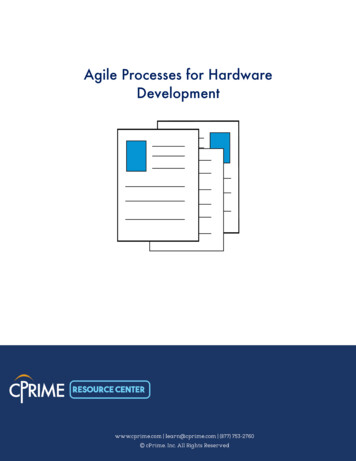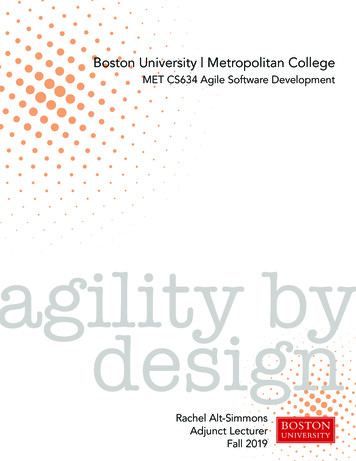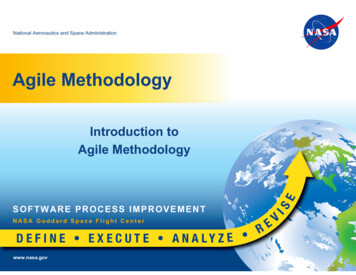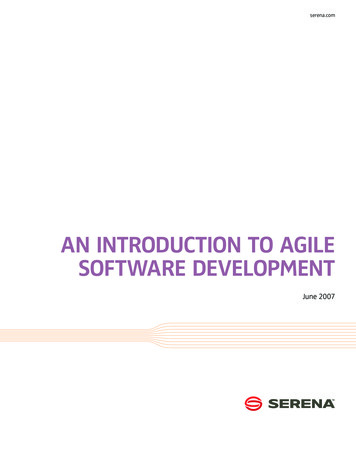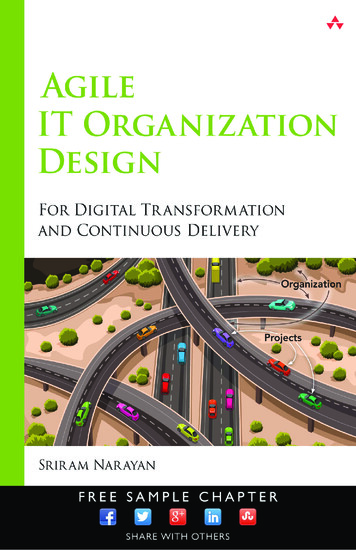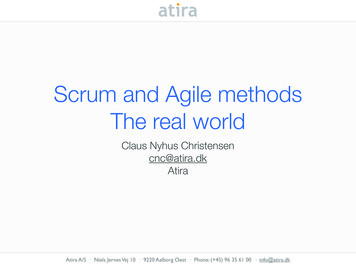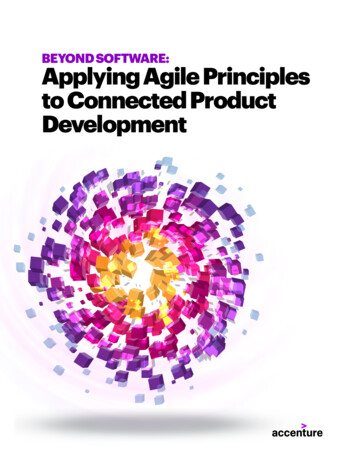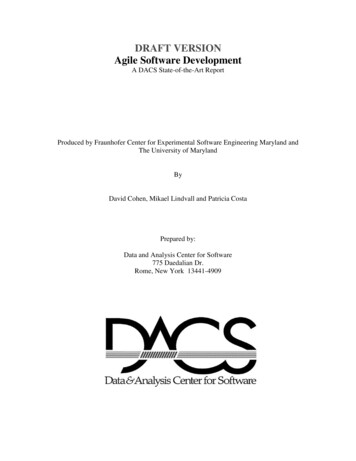
Transcription
DRAFT VERSIONAgile Software DevelopmentA DACS State-of-the-Art ReportProduced by Fraunhofer Center for Experimental Software Engineering Maryland andThe University of MarylandByDavid Cohen, Mikael Lindvall and Patricia CostaPrepared by:Data and Analysis Center for Software775 Daedalian Dr.Rome, New York 13441-4909
Form ApprovedOMB No. 0704-0188REPORT DOCUMENTATION PAGEPublic reporting burden for this collection of information is estimated to average 1 hour per response, including the time for reviewing instructions, searching existing data sources, gathering and maintaining the data needed, andcompleting and reviewing this collection of information. Send comments regarding this burden estimate or any other aspect of this collection of information, including suggestions for reducing this burden to Department of Defense,Washington Headquarters Services, Directorate for Information Operations and Reports (0704-0188), 1215 Jefferson Davis Highway, Suite 1204, Arlington, VA 22202-4302. Respondents should be aware that notwithstanding anyother provision of law, no person shall be subject to any penalty for failing to comply with a collection of information if it does not display a currently valid OMB control number. PLEASE DO NOT RETURN YOUR FORM TOTHE ABOVE ADDRESS.1. REPORT DATE (DD-MM-YYYY)2. REPORT TYPE31 January 2003N/A3. DATES COVERED (From - To)N/A4. TITLE AND SUBTITLE5a. CONTRACT NUMBERSPO700-98-40005b. GRANT NUMBERA State of the Art Report: Agile Software DevelopmentN/A5c. PROGRAM ELEMENT NUMBERN/A6. AUTHOR(S)5d. PROJECT NUMBERDavid Cohen, Mikael Lindvall and Patricia CostaN/A5e. TASK NUMBERN/A5f. WORK UNIT NUMBERN/A7. PERFORMING ORGANIZATION NAME(S) AND ADDRESS(ES)8. PERFORMING ORGANIZATION REPORTNUMBERFraunhofer Center for ExperimentalSoftware Engineering Maryland andThe University of Maryland, College Park,MarylandDACS SOAR 119. SPONSORING / MONITORING AGENCY NAME(S) AND ADDRESS(ES)10. SPONSOR/MONITOR’S ACRONYM(S)Defense Technical Information Center (DTIC)/AI8725 John J. Kingman Rd., STE 0944, Ft. Belvoir, VA 22060and Air Force Research Lab/IFED32 Brooks Rd., Rome, NY 13440DTIC-AI and AFRL/IFED11. SPONSOR/MONITOR’S REPORTNUMBER(S) N/A12. DISTRIBUTION / AVAILABILITY STATEMENTApproved for public release, distribution unlimited13. SUPPLEMENTARY NOTESAvailable from: DoD Data & Analysis Center for Software (DACS)PO Box 1400, Rome, NY 13442-140014. ABSTRACTThe purpose of this report is to address this interest and provide a comprehensive overview of the current State-of-the-Art as well as Stateof-the-Practice for Agile Methods. The first section discusses the history behind the trend, as well as the Agile Manifesto, a statement fromthe leaders of the Agile movement. The second section represents the State-of-the-Art and examines what it means to be Agile, discussesthe role of management, describes and compares some of the more popular methods, provides a guide for deciding where an Agileapproach is applicable, and lists common criticisms of Agile techniques. The third section represents State-of-the-Practice and summarizesempirical studies, anecdotal reports, and lessons learned. The report concludes with an Appendix that includes a detailed analysis ofvarious Agile Methods for the interested reader.15. SUBJECT TERMSAgile software development, software development models, incremental development, Agile Manifesto; Spiral Model, Capability MaturityModel, Lean Development, Crystal Methods, Extreme Programming, XP, Scrum, Lean Development, Agile Modeling, Feature DrivenDevelopment16. SECURITY CLASSIFICATION OF:a. REPORTunclassifiedb. ABSTRACTc. THIS PAGEunclassifiedunclassified17. LIMITATIONOF ABSTRACT18. NUMBEROF PAGESUL7119a. NAME OF RESPONSIBLE PERSON19b. TELEPHONE NUMBER (include areacode)315-334-4900Standard Form 298 (Rev. 8-98)Prescribed by ANSI Std. Z39.18
Table of Contents1.11.21.3HISTORY . 1THE AGILE MANIFESTO . 6AGILE AND CMM(I) . 72.12.22.32.4WHAT DOES IT MEAN TO BE AGILE? . 11A SELECTION OF AGILE METHODS . 11CHARACTERISTICS OF SELECTED AGILE METHODS . 23IS YOUR ORGANIZATION READY FOR AGILE METHODS?. 233.13.23.33.4EWORKSHOP ON AGILE METHODS . 25LESSONS LEARNED . 31CASE STUDIES . 32OTHER EMPIRICAL STUDIES . 406.16.26.36.46.5EXTREME PROGRAMMING . 53SCRUM . 56LEAN DEVELOPMENT . 58FEATURE DRIVEN DEVELOPMENT . 61DYNAMIC SYSTEMS DEVELOPMENT METHODOLOGY . 63i
List of FiguresFIGURE 1: THE SCRUM LIFECYCLE (FROM CONTROLCHAOS.COM) . 14FIGURE 2: CRYSTAL METHODS FRAMEWORK (FROM CRYSTALMETHODOLOGIES.ORG). 16FIGURE 3: FDD PROCESS (FROM TOGETHERCOMMUNITY.COM) . 17FIGURE 4: THE DSDM LIFECYCLE (FROM WWW.DSDM.ORG) . 19ii
List of TablesTABLE 1. PRESCRIPTIVE CHARACTERISTICS. 23TABLE 2. XP DEVELOPMENT SUPPORT . 53TABLE 3. XP MANAGEMENT SUPPORT . 54TABLE 4. XP COMMUNICATION SUPPORT. 54TABLE 5. XP DECISION-MAKING SUPPORT . 55TABLE 6. SCRUM DEVELOPMENT SUPPORT . 56TABLE 7. SCRUM MANAGEMENT SUPPORT . 56TABLE 8. SCRUM COMMUNICATION SUPPORT . 57TABLE 9. SCRUM DECISION MAKING SUPPORT. 58TABLE 10. LEAN DEVELOPMENT DEVELOPMENT SUPPORT . 59TABLE 11. LEAN DEVELOPMENT MANAGEMENT SUPPORT . 59TABLE 12. LEAN DEVELOPMENT COMMUNICATIONS SUPPORT . 60TABLE 13. LEAN DEVELOPMENT DECISION MAKING SUPPORT . 60TABLE 14. FEATURE DRIVEN DEVELOPMENT SUPPORT . 61TABLE 15. FEATURE DRIVEN DEVELOPMENT MANAGEMENT SUPPORT. 62TABLE 16. FEATURE DRIVEN DEVELOPMENT COMMUNICATION SUPPORT . 62TABLE 17. FEATURE DRIVEN DEVELOPMENT DECISION MAKING SUPPORT . 63TABLE 18. DYNAMIC SYSTEMS DEVELOPMENT METHODOLOGY DEVELOPMENT SUPPORT 64TABLE 19. DYNAMIC SYSTEMS DEVELOPMENT METHODOLOGY MANAGEMENT SUPPORT 64TABLE 20. DYNAMIC SYSTEMS DEVELOPMENT METHODOLOGY COMMUNICATION SUPPORT. 65TABLE 21. DYNAMIC SYSTEMS DEVELOPMENT METHODOLOGY DECISION MAKINGSUPPORT . 65iii
Acknowledgements:We would like to recognize our expert contributors who participated in the firsteWorkshop on Agile Methods and thereby contributed to the section on State-of-thePractice:Scott Ambler (Ronin International, Inc.)Ken Auer (RoleModel Software, Inc)Kent Beck (founder and director of the Three Rivers Institute)Winsor Brown (University of Southern California)Alistair Cockburn (Humans and Technology)Hakan Erdogmus (National Research Council of Canada)Peter Hantos (Xerox), Philip Johnson (University of Hawaii)Bil Kleb (NASA Langley Research Center)Tim Mackinnon (Connextra Ltd.)Joel Martin (National Research Council of Canada)Frank Maurer (University of Calgary)Atif Memon (University of Maryland and Fraunhofer Center for ExperimentalSoftware Engineering)Granville (Randy) Miller, (TogetherSoft)Gary Pollice (Rational Software)Ken Schwaber (Advanced Development Methods, Inc. and one of the developersof Scrum)Don Wells (ExtremeProgramming.org)William Wood (NASA Langley Research Center)We also would like to thank our colleagues who helped arrange the eWorkshop and coauthored that same section:Victor BasiliBarry BoehmKathleen DangleForrest ShullRoseanne TesorieroLaurie WilliamsMarvin ZelkowitzWe would like to thank Jen Dix for proof reading this report.iv
DRAFT VERSION1 IntroductionThe pace of life is more frantic than ever. Computers get faster every day. Start-ups riseand fall in the blink of an eye. And we stay connected day and night with our cablemodems, cell phones, and Palm Pilots. Just as the world is changing, so too is the art ofsoftware engineering as practitioners attempt to keep in step with the turbulent times,creating processes that not only respond to change but embrace it.These so-called Agile Methods are creating a buzz in the software developmentcommunity, drawing their fair share of advocates and opponents. The purpose of thisreport is to address this interest and provide a comprehensive overview of the currentState-of-the-Art, as well as State-of-the-Practice, for Agile Methods. As there is alreadymuch written about the motivations and aspirations of Agile Methods (e.g.,[Abrahamsson, et. al., 2002]), we will emphasize the latter. The first section discussesthe history behind the trend, as well as the Agile Manifesto, a statement from the leadersof the Agile movement [Beck, et. al., 2001]. The second section represents the State-ofthe-Art and examines what it means to be Agile, discusses the role of management,describes and compares some of the more popular methods, provides a guide for decidingwhere an Agile approach is applicable, and lists common criticisms of Agile techniques.The third section represents State-of-the-Practice and summarizes empirical studies,anecdotal reports, and lessons learned. The report concludes with an Appendix thatincludes a detailed analysis of various Agile Methods for the interested reader.The target audiences for this report include practitioners, who will be interested in thediscussion of the different methods and their applications, researchers who may want tofocus on the empirical studies and lessons learned, and educators looking to teach andlearn more about Agile Methods.It is interesting to note that there is a lack of literature describing projects where AgileMethods failed to produce good results. There are a number of studies reporting poorprojects due to a negligent implementation of an Agile method, but none wherepractitioners felt they executed properly but the method failed to deliver on its promise.This may be a result of a reluctance to publish papers on unsuccessful projects, or it mayin fact be an indication that, when implemented correctly, Agile Methods work.1.1HistoryAgile Methods are a reaction to traditional ways of developing software and acknowledgethe “need for an alternative to documentation driven, heavyweight software developmentprocesses” [Beck, et. al., 2001]. In the implementation of traditional methods, workbegins with the elicitation and documentation of a “complete” set of requirements,followed by architectural and high-level design, development, and inspection. Beginningin the mid-1990s, some practitioners found these initial development steps frustratingand, perhaps, impossible [Highsmith, 2002a]. The industry and technology move too1
DRAFT VERSIONfast, requirements “change at rates that swamp traditional methods” [Highsmith, et. al.,2000], and customers have become increasingly unable to definitively state their needs upfront while, at the same time, expecting more from their software. As a result, severalconsultants have independently developed methods and practices to respond to theinevitable change they were experiencing. These Agile Methods are actually a collectionof different techniques (or practices) that share the same values and basic principles.Many are, for example, based on iterative enhancement, a technique that was introducedin 1975 [Basili and Turner, 1975].In fact, most of the Agile practices are nothing new [Cockburn and Highsmith, 2001a]. Itis instead the focus and values behind Agile Methods that differentiate them from moretraditional methods. Software process improvement is an evolution in which newerprocesses build on the failures and successes of the ones before them, so to trulyunderstand the Agile movement, we need to examine the methods that came before it.According to Beck, the Waterfall Model [Royce, 1970] came first, as a way in which toassess and build for the users’ needs. It began with a complete analysis of userrequirements. Through months of intense interaction with users and customers, engineerswould establish a definitive and exhaustive set of features, functional requirements, andnon-functional requirements. This information is well-documented for the next stage,design, where engineers collaborate with others, such as database and data structureexperts, to create the optimal architecture for the system. Next, programmers implementthe well-documented design, and finally, the complete, perfectly designed system istested and shipped [Beck, 1999a].This process sounds good in theory, but in practice it did not always work as well asadvertised. Firstly, users changed their minds. After months, or even years, of collectingrequirements and building mockups and diagrams, users still were not sure of what theywanted – all they knew was that what they saw in production was not quite “it.”Secondly, requirements tend to change mid-development and when requirements arechanged, it is difficult to stop the momentum of the project to accommodate the change.The traditional methods may well start to pose difficulties when change rates are stillrelatively low [Boehm, 2002] because programmers, architects, and managers need tomeet, and copious amounts of documentation need to be kept up to date to accommodateeven small changes [Boehm, 1988]. The Waterfall model was supposed to fix theproblem of changing requirements once and for all by freezing requirements and notallowing any change, but practitioners found that requirements just could not be pinneddown in one fell swoop as they had anticipated [Beck, 1999a].Incremental and iterative techniques focusing on breaking the development cycle intopieces evolved from the Waterfall model [Beck, 1999a], taking the process behindWaterfall and repeating it throughout the development lifecycle. Incrementaldevelopment aimed to reduce development time by breaking the project into overlappingincrements. As with the Waterfall model, all requirements are analyzed beforedevelopment begins; however, the requirements are then broken into increments of stand-2
DRAFT VERSIONalone functionality. Development of each increment may be overlapped, thus saving timethrough concurrent “multitasking” across the project.While incremental development looked to offer time savings, evolutionary methods likeiterative development and the Spiral Model [Boehm, 1988] aimed to better handlechanging requirements and manage risk. These models assess critical factors in astructured and planned way at multiple points in the process rather than trying to mitigatethem as they appear in the project.Iterative development breaks the project into iterations of variable length, each producinga complete deliverable and building on the code and documentation produced before it.The first iteration starts with the most basic deliverable, and each subsequent iterationadds the next logical set of features. Each piece is its own waterfall process beginningwith analysis, followed by design, implementation, and finally testing. Iterativedevelopment deals well with change, as the only complete requirements necessary are forthe current iteration. Although tentative requirements need to exist for the next iteration,they do not need to be set in stone until the next analysis phase. This approach allows forchanging technology or the customer to change their mind with minimal impact on theproject’s momentum.Similarly, the Spiral Model avoids detailing and defining the entire system upfront.Unlike iterative development, however, where the system is built piece by pieceprioritized by functionality, Spiral prioritizes requirements by risk. Spiral and iterativedevelopment offered a great leap in agility over the Waterfall process, but somepractitioners believed that they still did not respond to change as nimbly as necessary inthe evolving business world. Lengthy planning and analysis phases, as well as asustained emphasis on extensive documentation, kept projects using iterative techniquesfrom being truly Agile, in comparison with today’s methods.Another important model to take into account in these discussions is the CapabilityMaturity Model (CMM1) [Paulk, 1993], “a five-level model that describes goodengineering and management practices and prescribes improvement priorities forsoftware organizations” [Paulk, 2001]. The model defines 18 key process areas and 52goals for an organization to become a level 5 organization. Most software organizations’maturity level is ‘Chaotic’ (CMM level one) and only a few are ‘Optimized’ (CMM levelfive). CMM focuses mainly on large projects and large organizations, but can be tailoredto fit small as well as large projects due to the fact that it is formulated in a very generalway that fits diverse organizations’ needs. The goals of CMM are to achieve processconsistency, predictability, and reliability (Paulk, 2001).Ken Schwaber was one practitioner looking to better understand the CMM-basedtraditional development methods. He approached the scientists at the DuPont Chemical’sAdvanced Research Facility posing the question: “Why do the defined processesadvocated by CMM not measurably deliver?” [Schwaber, 2002]. After analyzing the1We use the terms CMM and SW-CMM interchangeably to denote the Software CMM from the SoftwareEngineering Institute (SEI).3
DRAFT VERSIONdevelopment processes, they returned to Schwaber with some surprising conclusions.Although CMM focuses on turning software development into repeatable, defined, andpredictable processes, the scientists found that many of them were, in fact, largelyunpredictable and unrepeatable because [Schwaber, 2002]: Applicable first principles are not presentThe process is only beginning to be understoodThe process is complexThe process is changing and unpredictableSchwaber, who would go on to develop Scrum, realized that to be truly Agile, a processneeds to accept change rather than stress predictability [Schwaber, 2002]. Practitionerscame to realize that methods that would respond to change as quickly as it arose werenecessary [Turk, et. al., 2002], and that in a dynamic environment, “creativity, notvoluminous written rules, is the only way to manage complex software developmentproblems” [Cockburn and Highsmith, 2001a].Practitioners like Mary Poppendieck and Bob Charette2 also began to look to otherengineering disciplines for process inspiration, turning to one of the more innovateindustry trends at the time, Lean Manufacturing. Started after World War II by ToyodaSakichi, its counter-intuitive practices did not gain popularity in the United States untilthe early 1980s. While manufacturing plants in the United States ran productionmachines at 100% and kept giant inventories of both products and supplies, Toyoda keptonly enough supplies on hand to run the plant for one day, and only produced enoughproducts to fill current orders. Toyoda also tightly integrated Dr. W. Edwards Deming’sTotal Quality Management philosophy with his process. Deming believed that peopleinherently want to do a good job, and that managers needed to allow workers on the floorto make decisions and solve problems, build trust with suppliers, and support a “cultureof continuous improvement of both process and products” (Poppendieck, 2001). Demingtaught that quality was a management issue and while Japanese manufacturers werecreating better and cheaper products, United States manufacturers were blaming qualityissues on their workforce [Poppendieck, 2001].Poppendieck lists the 10 basic practices which make Lean Manufacturing so successful,and their application to software development [Poppendieck, 2001]:1. Eliminate waste – eliminate or optimize consumables such as diagrams andmodels that do not add value to the final deliverable2. Minimize inventory – minimize intermediate artifacts such as requirements anddesign documents3. Maximize flow – use iterative development to reduce development time4. Pull from demand – support flexible requirements5. Empower workers – generalize intermediate documents, “tell developers whatneeds to be done, not how to do it”2Bob Charette’s “Lean Development” method will be discussed later.4
DRAFT VERSION6. Meet customer requirements – work closely with the customer, allowing them tochange their minds7. Do it right the first time – test early and refactor when necessary8. Abolish local optimization – flexibly manage scope9. Partner with suppliers – avoid adversarial relationships, work towards developingthe best software10. Create a culture of continuous improvement – allow the process to improve, learnfrom mistakes and successesIndependently, Kent Beck rediscovered many of these values in the late 1990s when hewas hired by Chrysler to save their failing payroll project, Chrysler ComprehensiveCompensation (C3). The project was started in the early 1990s as an attempt to unifythree existing payroll systems (The C3 Team, 1998) and had been declared a failure whenBeck arrived. Beck, working with Ron Jeffries [Highsmith, et. al., 2000], decided toscrap all the existing code and start the project over from scratch. A little over a yearlater, a version of C3 was in use and paying employees. Beck and Jeffries were able totake a project that had been failing for years and turn it around 180 degrees. The C3project became the first project to use eXtreme Programming [Highsmith, et. al., 2000](discussed in detail later), relying on the same values for success as Poppendiek’s LeanProgramming.Similar stories echo throughout the development world. In the early 1990s, the IBMConsulting Group hired Alistair Cockburn to develop an object-oriented developmentmethod [Highsmith, et. al., 2000]. Cockburn decided to interview IBM developmentteams and build a process out of best practices and lessons learned. He found that “teamafter successful team ‘apologized’ for not following a formal process, for not using hightech [tools], for ‘merely’ sitting close to each other and discussing while they went,”while teams that had failed followed formal processes and were confused why it hadn’tworked, stating “maybe they hadn’t followed it well enough” [Highsmith, et. al., 2000].Cockburn used what he learned at IBM to develop the Crystal Methods (discussed indetail later).The development world was changing and, while traditional methods were hardly fallingout of fashion, it was obvious that they did not always work as intended in all situations.Practitioners recognized that new practices were necessary to better cope with changingrequirements. And these new practices must be people-oriented and flexible, offering“generative rules” over “inclusive rules” which break down quickly in a dynamicenvironment [Cockburn and Highsmith, 2001a]. Cockburn and Highsmith summarize thenew challenges facing the traditional methods: Satisfying the customer has taken precedence over conforming to original plansChange will happen – the focus is not how to prevent it but how to better copewith it and reduce the cost of change throughout the development process“Eliminating change early means being unresponsive to business conditions – inother words, business failure”“The market demands and expects innovative, high quality software that meets itsneeds – and soon”5
DRAFT VERSION1.2The Agile Manifesto“[A] bigger gathering of organizational anarchists would be hard to find” Beck stated,[Beck, et. al., 2001] when seventeen of the Agile proponents came together in early 2001to discuss the new software developments methods. “What emerged was the Agile‘Software Development’ Manifesto. Representatives from Extreme Programming (XP),SCRUM, DSDM, Adaptive Software Development, Crystal, Feature-DrivenDevelopment, Pragmatic Programming, and others sympathetic to the need for analternative to documentation driven, heavyweight software development processesconvened” [Beck, et. al., 2001]. They summarized their viewpoint, saying that “the Agilemovement is not anti-methodology, in fact, many of us want to restore credibility to theword methodology. We want to restore a balance. We embrace modeling, but not inorder to file some diagram in a dusty corporate repository. We embrace documentation,but not hundreds of pages of never-maintained and rarely used tomes. We plan, butrecognize the limits of planning in a turbulent environment” [Beck, et. al., 2001]. TheManifesto itself reads as follows [Beck, et. al., 2001]:We are uncovering better ways of developing software bydoing it and helping others do it. Through this work wehave come to value: Individuals and interaction over process and toolsWorking software over comprehensive documentationCustomer collaboration over contract negotiationResponding to change over following a planThat is, while there is a value in the items on the right, wevalue the items on the left more.The Manifesto has become an important piece of the Agile Movement, in that itcharacterizes the values of Agile methods and how Agile distinguishes itself fromtraditional methods. Glass amalgamates the best of the Agile and traditional approachesby analyzing the Agile manifesto and comparing it with traditional values [Glass, 2001].On Individuals and interaction over process and tools: Glass believes that the Agilecommunity is right on this point: “Traditional software engineering has gotten too caughtup in its emphasis on process” [Glass, 2001]. At the same time “most practitionersalready know that people matter more than process” [Glass, 2001].On Working software over comprehensive documentation: Glass agrees with the Agilecommunity on this point too, although with some caveat: “It is important to rememberthat the ultimate result of building software is product. Documentation matters but overthe years, the traditionalists made a fetish of documentation. It became the prime goal ofthe document-driven lifecycle” [Glass, 2001].6
DRAFT VERSIONOn Customer collaboration over contract negotiation: Glass sympathizes with bothsides regarding this statement: “I deeply believe in customer collaboration, and without it nothing is going to go well. I also believe in contracts, and I would notundertake any significant collaborative effort without it” [Glass, 2001]On Responding to change over following a plan: Both sides are right regarding thisstatement, according to Glass: “Over they years, we have learned two contradictorylessons: 1. [C]ustomers and users do not always know what they want at the outset of asoftware project, and we must be open to change during project execution” and 2.Requirement change was one of the most common causes of software project failure.”[Glass, 2001].This view, that both camps can learn from each other, is commonly held, as we will seein the next section.1.3Agile and CMM(I)As mentioned above, Agile is a reaction against traditional methodologies, also known asrigorous or plan-driven methodologies [Boehm, 2002]. One of the models often used torepresent traditional methodologies is the Capability Maturity Model (CMM3) [Paulk,1993] and its replacement4 CMMI, an extension of CMM based on the same values5. Notmuch has been written about CMMI yet, but we believe that for this discussion, what isvalid for CMM is also valid for CMMI6.As mentioned above, the goals of CMM are to achieve process consistency,predictability, and reliability. Its proponents claim that it can be tailored to also fit theneeds of small projects even though it was designed for large projects and largeorganizations [Paulk, 2001].Most Agile proponents do not, however, believe CMM fits their needs at all. “If onewere to ask a typical software engineer whether the Capability Maturity Model forSoftware and process improvement were applicable to Agile Methods, the responsewould most likely range from a blank stare to a hysterical laughter” [Turner and Jain,2002]. One reason is that “CMM is a belief in software development as a defined process [that] can be defined in detail, [that] algorithms can be defined, [that] results can beaccurately measured, and [that] measured variations can be used to refine the processesuntil they are repeatable within very close tolerances” [Highsmith, 2002b]. “For projectswith a
Agile Software Development A DACS State-of-the-Art Report Produced by Fraunhofer Center for Experimental Software Engineering Maryland and The University of Maryland By David Cohen, Mikael Lindvall and Patricia Costa Prepared by: Data and Analysis Center



